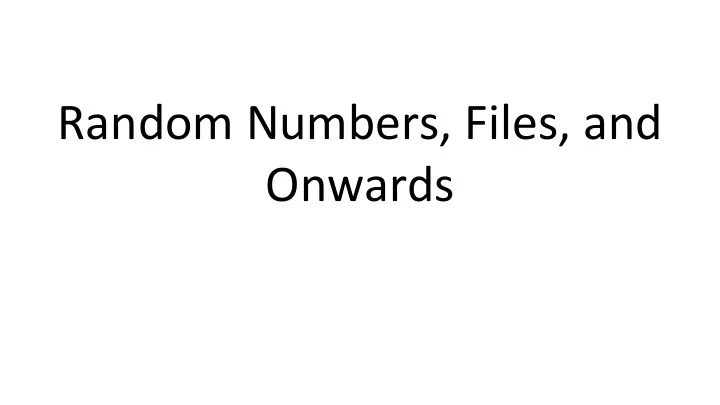

Random Numbers, Files, and Onwards
Random Numbers Computers cannot produce truly random numbers. We make do with pseudo-random numbers, which are good enough. The pseudo-random generation algorithm is given a seed value. The same seed will always produce the same sequence of pseudo-random values.
Random Numbers The random module provides random number generation. import random To set the seed to the current system time: random.seed() To set the seed to a specific value: random.seed(x)
Random Numbers To generate a random floating point value in the range [0.0, 1.0): random.random() To generate a random integer in the range [a, b]: random.randint(a, b) To shuffle a list of values (in-place): random.shuffle(x)
Exercise: Random Numbers Try generating some random numbers! Test how the same seed leads to the same output.
Files File access is built in to Python - no module is required.
Opening a File To open a file: myfile = open(filename, mode) ● filename should be a string containing the filename. ● mode should be a string containing one of several possible values, indicating how the file should be treated: ○ r - File is read-only. ○ w - File is write-only, and will be overwritten completely. ○ a - File is write-only, but data will be added to the end. ○ https://docs.python.org/3/library/functions.html#open ● The function returns a file object, which we need to store in a variable.
Closing a File We should close the file when we are finished with it. myfile.close() Once closed, the file object should not be used further.
Writing to a File To write to a file: myfile.write(data) Escape codes: ● \n will be replaced with a newline ● \t will be replaced with a tab ● \' or \" will be replaced with a single or double quote ● \\ will be replaced with a single backslash myfile.write(“First line.\nSecond line.\n\”Quoted line.\””) Alternatively, use myfile.writelines(data) , where data is a list of strings, to write each string as a line in the file.
Reading from a File data = myfile.read() Read entire file. data = myfile.read(x) Read x bytes of file. data = myfile.readline() Read next line of file. data = myfile.readline(x) Read next x bytes or the next line of the file - whichever is shorter. data = myfile.readlines() Read entire file, as list of lines.
Exercise: Files Try reading and writing from and to files!
Where to go from here... We have now reached the end of the taught part of this course. You have learnt a lot of Python - enough to write some quite complex programs. ○ There will still be things we haven’t covered - if you ever find yourself wondering if something is possible, try searching online! The key thing now is practice ... For the remaining sessions, we will provide a list of longer challenges and exercises, for you to pick and choose what to practice with.
Recommend
More recommend